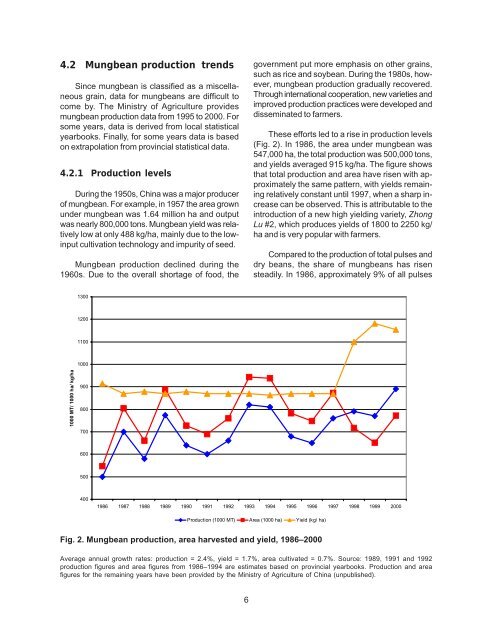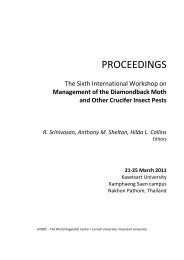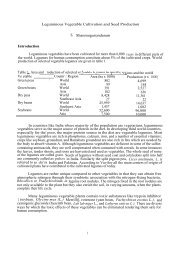The Impact of Mungbean Research in China
The Impact of Mungbean Research in China
The Impact of Mungbean Research in China
You also want an ePaper? Increase the reach of your titles
YUMPU automatically turns print PDFs into web optimized ePapers that Google loves.
4.2 <strong>Mungbean</strong> production trendsS<strong>in</strong>ce mungbean is classified as a miscellaneousgra<strong>in</strong>, data for mungbeans are difficult tocome by. <strong>The</strong> M<strong>in</strong>istry <strong>of</strong> Agriculture providesmungbean production data from 1995 to 2000. Forsome years, data is derived from local statisticalyearbooks. F<strong>in</strong>ally, for some years data is basedon extrapolation from prov<strong>in</strong>cial statistical data.4.2.1 Production levelsDur<strong>in</strong>g the 1950s, Ch<strong>in</strong>a was a major producer<strong>of</strong> mungbean. For example, <strong>in</strong> 1957 the area grownunder mungbean was 1.64 million ha and outputwas nearly 800,000 tons. <strong>Mungbean</strong> yield was relativelylow at only 488 kg/ha, ma<strong>in</strong>ly due to the low<strong>in</strong>putcultivation technology and impurity <strong>of</strong> seed.<strong>Mungbean</strong> production decl<strong>in</strong>ed dur<strong>in</strong>g the1960s. Due to the overall shortage <strong>of</strong> food, thegovernment put more emphasis on other gra<strong>in</strong>s,such as rice and soybean. Dur<strong>in</strong>g the 1980s, however,mungbean production gradually recovered.Through <strong>in</strong>ternational cooperation, new varieties andimproved production practices were developed anddissem<strong>in</strong>ated to farmers.<strong>The</strong>se efforts led to a rise <strong>in</strong> production levels(Fig. 2). In 1986, the area under mungbean was547,000 ha, the total production was 500,000 tons,and yields averaged 915 kg/ha. <strong>The</strong> figure showsthat total production and area have risen with approximatelythe same pattern, with yields rema<strong>in</strong><strong>in</strong>grelatively constant until 1997, when a sharp <strong>in</strong>creasecan be observed. This is attributable to the<strong>in</strong>troduction <strong>of</strong> a new high yield<strong>in</strong>g variety, ZhongLu #2, which produces yields <strong>of</strong> 1800 to 2250 kg/ha and is very popular with farmers.Compared to the production <strong>of</strong> total pulses anddry beans, the share <strong>of</strong> mungbeans has risensteadily. In 1986, approximately 9% <strong>of</strong> all pulses13001200110010001000 MT/ 1000 ha/ kg/ha9008007006005004001986 1987 1988 1989 1990 1991 1992 1993 1994 1995 1996 1997 1998 1999 2000Production (1000 MT) Area (1000 ha) Yield (kg/ ha)Fig. 2. <strong>Mungbean</strong> production, area harvested and yield, 1986–2000Average annual growth rates: production = 2.4%, yield = 1.7%, area cultivated = 0.7%. Source: 1989, 1991 and 1992production figures and area figures from 1986–1994 are estimates based on prov<strong>in</strong>cial yearbooks. Production and areafigures for the rema<strong>in</strong><strong>in</strong>g years have been provided by the M<strong>in</strong>istry <strong>of</strong> Agriculture <strong>of</strong> Ch<strong>in</strong>a (unpublished).6
















